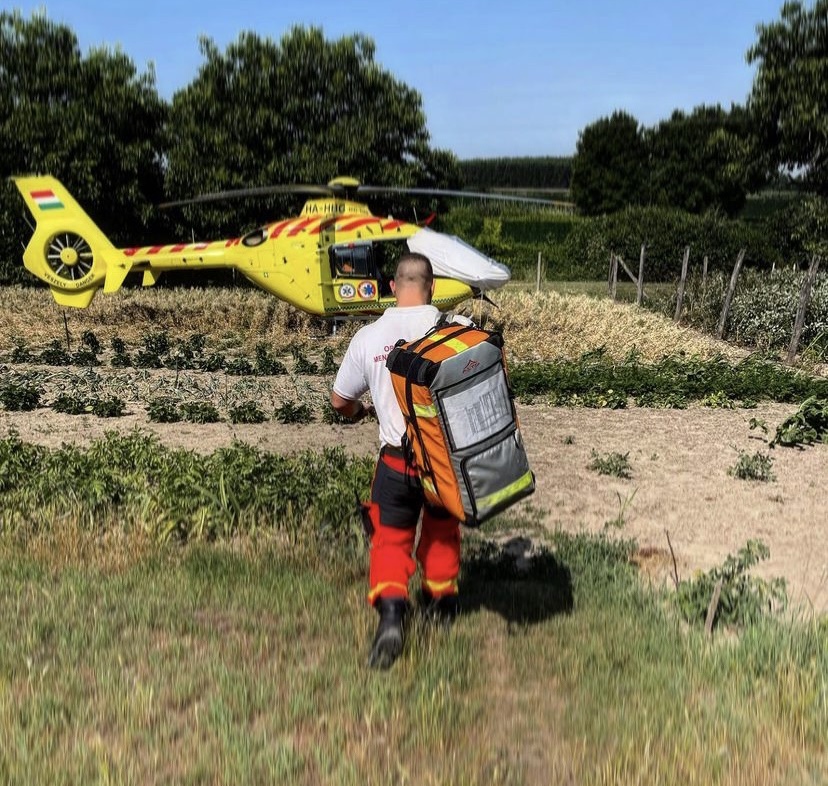
IN the early hours of 15 April 1912, the passenger steamship RMS Carpathia, en route from New York to Europe, picked up a distress call from 58 nautical miles away. A British passenger liner on her maiden voyage had struck an iceberg and was starting to sink. The Carpathia reached the scene four hours later, finding only lifeboats carrying 706 frozen, injured and traumatised survivors.
The man put in charge of the rescue was 26-year-old Árpád Lengyel who, having volunteered with the Budapest Volunteer Ambulance Association (BÖME) in his native Hungary from the age of 18, was the only doctor on board with experience as a paramedic.
Árpád Lengyel would become revered as the Hungarian doctor who saved the survivors of the Titanic, and the Budapest Volunteer Ambulance Association as the first Hungarian organised ambulance system, a predecessor of the Hungarian National Ambulance Service, the OMSZ.

An amazing adrenaline bomb
Rescue work today is a far cry from when 18-year-old Árpád Lengyel joined the Budapest Volunteer Ambulance Association in 1904. It is also markedly different from when a second-year medical student started volunteering as an emergency nurse in the OMSZ in the early 2000s. Back then a far more rudimentary system was in place, Dr Gábor Csató told the website civilek.hu in June 2023. Ambulances were dispatched via radio knowing neither the exact coordinates nor any details. “At most we could guess what task awaited us,” he said. “When we arrived, everyone looked at us as the embodiment of hope. While this was an overwhelming responsibility, it was also an uplifting feeling and an amazing adrenaline bomb.”
Stories told by his great-grandfather, a county nurse, had sparked his interest in medicine. Throughout his studies at the Medical University of Debrecen he continued to devote his nights and weekends to rescue work, little knowing he’d be heading up the OMSZ by his mid-thirties.
The OMSZ is a central ambulance service with seven regional organisations. As director-general since 2017, Dr Gábor Csató is responsible for managing the largest healthcare employer in Hungary, with 8,500 employees and 256 ambulance stations. Its close to 800 ambulances cover 40 million kilometres per year in response to 1,2 million emergencies, the aim being that any emergency be reached within 15 minutes.
His innovative leadership and use of technology to drive game-changing results is recognised as a major factor in OMSZ’s recent success in the EMS Angels Awards. The service claimed seven out of the 15 diamond awards awarded across Europe for the first quarter of 2023, with each of its seven regions meeting the highest standard in prehospital stroke care.

Continuous performance auditing
Angels consultant in Hungary Zsolt Lakatos has given thought to why the 2023 results were so much better than the previous year when only one out of seven regions qualified for diamond status, the rest having to settle for gold. His analysis points to a highly effective combination of central oversight and regional participation, along with education, feedback and data-lead change.
The improvement project is driven from HQ where Dr Csató has prioritised internal data collection within a culture of quality monitoring, and introduced the technology to support it. His enthusiasm for new solutions and quality improvement is shared by the medical director, Dr György Pápai who is in charge of a continuous performance auditing process that is aided by digital data collection.
“Innovation is embedded in the DNA of the organisation,” Dr Csató told tech magazine The Medical Futurist in a 2020 interview. “An immense level of innovation is experienced in smart healthcare solutions nowadays.”
The operation of OMSZ generates huge amounts of data that, by using smart algorithms, can be used to predict for example the statistical possibility of accidents in specific locations, or help with capacity planning.
Unlike the radio technology from his student days, under Dr Csató’s leadership every OMSZ ambulance is equipped with a tablet where every case is recorded in a centrally standardised form. Measuring performance against EMS awards criteria has lead to amendments with specific relevance for stroke patients, such as “patient medication” and “last seen normal” being added as mandatory fields.
On-scene-time delays are routinely analysed with feedback provided to regional directors and station chiefs, and performance failures are filtered by the central unit where they trigger analysis, feedback, discussion and corrective actions that include training.
The elearnings that form part of the mandatory EMS training programme have been updated to include stroke, and regional managers receive support from Angels to provide stroke-specific training for dispatch, nurses and paramedics. Angels-facilitated monthly quality meetings where both hospitals and EMS are present have created another important feedback channel, with improved communication ultimately paying dividends in all emergencies, not only stroke.

Stories that inspire
That the EMS Angels Awards have helped identify systemic and local deficiencies, is also the view of Ferenc Toldi, an ambulance officer with the OMSZ for 30 years. It may even have introduced a spirit of friendly competition.
Ferenc says, “Last year’s awards, or in some cases the lack of any award, boosted regions to take action and to correct the issues revealed during the Angels quality monitoring programme. One region, the Southern Great Plain Region, proved to be an example as they won a diamond award last year, and others took inspiration from their story.”
Data collection was ultimately what turned gold into diamonds, Ferenc says. “Ongoing data collection from the whole system and close monitoring of all performance indicators have been key. Also, involving regional directors and coordinators as champions in their region was crucial, as they were determined to resolve any issue based on our own and Angels’ performance indicators.
“The more data we have, and the more thoroughly and precisely we analyse this data, the more valuable the feedback. We can find the gaps in the system, and we apply these findings when we create the next protocol set.
“As in other fields of life, analysis and synthesis of data lead to spectacular improvement.”


